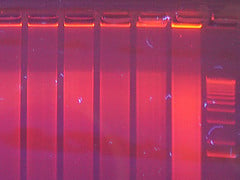Question:
How to prevent genomic DNA samples from degrading quickly?
The Protein Man Says:
Protein analysis and genetic research involving genomic DNA samples can easily be altered or corrupted by genomic DNA degradation. Once genomic DNA unfolds or breaks apart, the conclusions provided by any examination or assay may not be valid. What causes this degradation, and how can these circumstances be identified and prevented?
Threats to Genomic DNA Samples
Fresh DNA samples are typically drawn from capillary blood, buccal scrapes from the inside of the mouth, paraffin embedded samples, and organ biopsies. Proper tissue preservation methods can safeguard these samples from damage. DNA can also be protected if samples are kept safe from UV radiation, temperature extremes, pH extremes, and environments with high salt concentrations.
 Assays can also produce skewed or corrupted results if DNA samples are old, have been stored at room temperature, have been frozen or thawed several times, or have been extracted from formalin fixed paraffin. Incorrect and incomplete purification procedures can also leave residual nucleic tissue behind that can interfere with the accuracy of a given assay. Any form of degradation, corruption, or damage can reduce the number of intact DNA templates until the sample size is too small for amplification.
Assays can also produce skewed or corrupted results if DNA samples are old, have been stored at room temperature, have been frozen or thawed several times, or have been extracted from formalin fixed paraffin. Incorrect and incomplete purification procedures can also leave residual nucleic tissue behind that can interfere with the accuracy of a given assay. Any form of degradation, corruption, or damage can reduce the number of intact DNA templates until the sample size is too small for amplification.
Preventing Genomic DNA Degradation: Temperature Sensitivity
Buccal tissue should be kept frozen at -15 to -25 degrees Celsius. Organ biopsy tissue should be stored in liquid nitrogen at -80 degrees Celsius, or should be kept frozen at -15 to -25 degrees. Whole blood should also be stored at -15 to -25 degrees and should be thawed at room temperature before use.
If genomic DNA degradation has clearly occurred, or samples have been exposed to any of the harmful conditions described above, perform all assays multiple times to increase the likelihood of accurate results. Factor the extent and nature of the degradation into any conclusions drawn from the study.
Preventing Genomic DNA Degradation: Protein Degradation
There are several proteins found in all tissues that play a role in regulating DNA. These nucleases are involved in DNA repair processes, which involve DNA replication, base excision repair, nucleotide excision repair, mismatch repair, and double strand break repair. The nucleases, also known as DNases (Deoxyribonuclease), are tightly regulated in normal cells, however protein or DNA extraction releases these proteins so they can freely break down DNA.
Several methods can be used to prevent the nucleases breaking down DNA, including:
-
Low temperatures: These inhibit nuclease activity
-
Chemical Inhibitors: Block DNase activity. Inhibitors include 2-mercaptoethanol, Ca2+, EGTA, SDS and iodoacetate.
-
Protein Precipitation: Most routine DNA isolation methods have a protein precipitation step that will remove the nucleases.
In summary, the key steps to prevent DNA degradation are:
-
Correct handling & storage of starting material.
-
Perform Extractions at 4°C, on ice or in the cold.
-
Inhibit nuclease activity.
-
Store purified DNA correctly.
Image By: kaibara87






